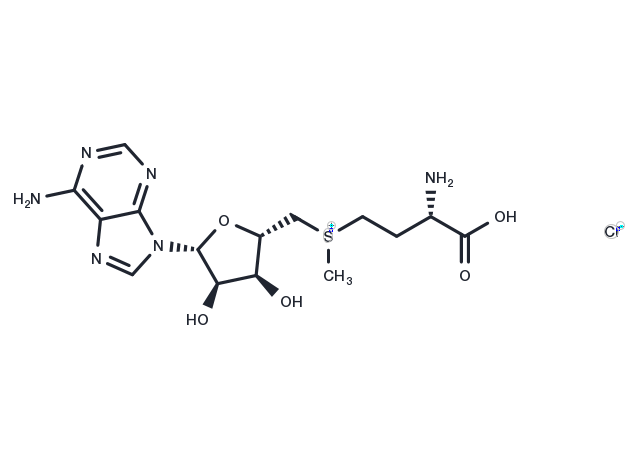Powder: -20°C for 3 years | In solvent: -80°C for 1 year


S-(5'-Adenosyl)-L-methionine chloride is a natural product. The catalog number is TN6669 and the CAS number is 24346-00-7. S-(5'-Adenosyl)-L-methionine chloride can be used as a reference standard.

| Pack Size | Availability | Price/USD | Quantity |
|---|---|---|---|
| 25 mg | Inquiry | $ 331.00 |
| Description | S-(5'-Adenosyl)-L-methionine chloride is a natural product. The catalog number is TN6669 and the CAS number is 24346-00-7. S-(5'-Adenosyl)-L-methionine chloride can be used as a reference standard. |
| In vitro | METHODS AND RESULTS:Norepinephrine (NE) is detected amperometrically using the enzyme Phenylethanolamine N-methyl transferase and cofactor S-(5'-Adenosyl)-L-methionine chloride dihydrochloride with disposable screen printed mesoporous carbon electrodes. The role of internal surface area and pore size of the mesoporous carbon is systematically examined using soft-templated, mesoporous silica-carbon powders with highly microporous walls obtained from etching of the silica to produce powders with surface areas ranging from 671-2339 m(2)g(-1). As the surface area increases, the sensitivity of the biosensor at very low NE concentrations (0-500 pg mL(-1)) in phosphate buffered saline (PBS) increases just as the current signal increases with respect to the NE concentration of 81-1581 μA mL ng(-1) cm(-2) for the mesoporous carbons. CONCLUSIONS: The best performing electrode provides similar sensitivity in whole rabbit blood in comparison to PBS despite no membrane layer to filter the non-desired reactants; the small (<5 nm) pore size and large internal surface area acts to minimize non-specific events that decrease sensitivity. |
| Molecular Weight | 434.9 |
| Formula | C15H23ClN6O5S |
| CAS No. | 24346-00-7 |
Powder: -20°C for 3 years | In solvent: -80°C for 1 year
You can also refer to dose conversion for different animals. More
bottom
Please see Inhibitor Handling Instructions for more frequently ask questions. Topics include: how to prepare stock solutions, how to store products, and cautions on cell-based assays & animal experiments, etc.
S-(5'-Adenosyl)-L-methionine chloride 24346-00-7 S(5'Adenosyl)Lmethionine chloride S-(5'-Adenosyl)-L-methionine Chloride S (5' Adenosyl) L methionine chloride inhibitor inhibit
